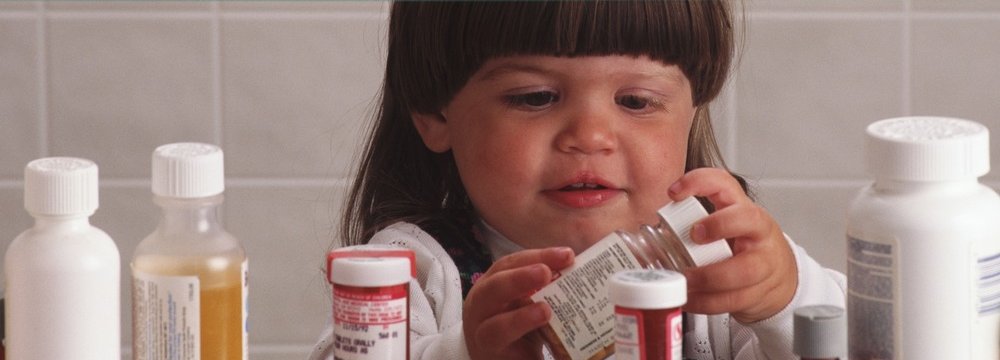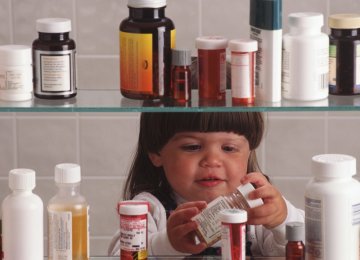An estimated 5,500 Iranians die each year due to poisoning as per data from Iran’s Legal Medicine Organization. The majority are victims of narcotics abuse followed by overdose of medicine and carbon monoxide poisoning.
The rates of accidental and intentional poisoning have risen significantly in recent years due to a variety of reasons. Poisoning can occur when a toxic substance (toxin) is swallowed (ingested) or breathed in through the mouth or nose (inhaled), gets on the skin or in the eyes, or is injected under the skin (through a bite or sting).
Improper storage and overdose of medication, ignorance of the warning notices on labels and substance abuse all have fatal effects. At high enough levels, just about any substance can be poisonous.
The National Poison Prevention Week is observed in Iran annually from October 22-28 to draw public attention and raise awareness about the risks of poisoning and toxic substances.
Speaking to ISNA, Yasna Behmanesh, secretary of the Central Division of Iran Drug and Poison Information Center at the Food and Drug Administration, listed a number of programs undertaken during the week.
Distribution of informative brochures, posters and educational pamphlets in health centers, schools, universities, factories, institutes, and mosques, educational messages on billboards across the city, raising awareness through mass media including newspapers, radio, television as well as SMS, holding expos and art competitions, printing health messages on office document headers, water and electricity bills, were among the programs.
Drug Poisoning Common
In recent years, 700 Iranians have died of drug poisoning annually. The mortality rate rose from 9% in 2010 to 14.4% in 2014. In 2011, around 7,300 patients were referred to Loghman-e-Hakim Toxicology Hospital in Tehran while the number increased to 17,200 in 2015, registering a 2.3 times growth over a period of five years, Salamat News reported.
The majority of people visiting hospitals for chemical poisoning by medicine are predominantly affected by drugs that impact the nervous system such as antidepressants, tranquilizers, antipsychotics, anticonvulsants and painkillers. “From 2010 to 2015, between 75% and 80% of patients were medically poisoned. While 14% of such cases may be fatal, the rest are successfully treated,” Behmanesh said.
Wrong prescription or administration of medicines can lead to poisoning and loss of life, but these instances are rare compared to the number of poisoning cases due to suicide attempts or narcotics overdose.
Childhood poisoning is also another issue that must be given attention. Around 40% of children referred to Tehran’s Mofid Children’s Hospital are for medicinal poisoning. Among them, nearly 80% are due to accidental ingestion of medicine, according to data from 2010-2015.
Medication dosing mistakes and unsupervised ingestions are common ways that children are poisoned. Children are the prime victims of poisoning due to their curiosity, inability to read warning labels, a desire to imitate adults, and inadequate supervision. The elderly are the second most likely group to be poisoned. Mental confusion, poor eyesight, and the use of multiple drugs are the leading reasons why this group has a high rate of accidental poisoning.
CO Highly Toxic
Another common substance which can impair body functions once inhaled is carbon monoxide, and 11% to 16% of morbidity in the total number of deaths in recent years in the country is due to CO poisoning. Domestic heating appliances when operated incorrectly are often responsible for the production of the colorless, odorless and tasteless, but highly toxic gas.
Behmanesh called for more attention to the issue at the start of the cold season.
Poisons are common in the home and workplace and are basically two major types. One group consists of products that were never meant to be ingested or inhaled, such as shampoo, paint thinner, pesticides, houseplant leaves, and carbon monoxide. The other contains products that are ingested in small quantities, but harmful if taken in large amounts, such as pharmaceuticals, medicinal herbs, or alcohol.
Other types of poisons include the bacterial toxins that cause food poisoning, such as Escherichia coli; heavy metals, such as the lead found in the paint on older houses, and the venom found in the bites and stings of some animals and insects.






Add new comment
Read our comment policy before posting your viewpoints